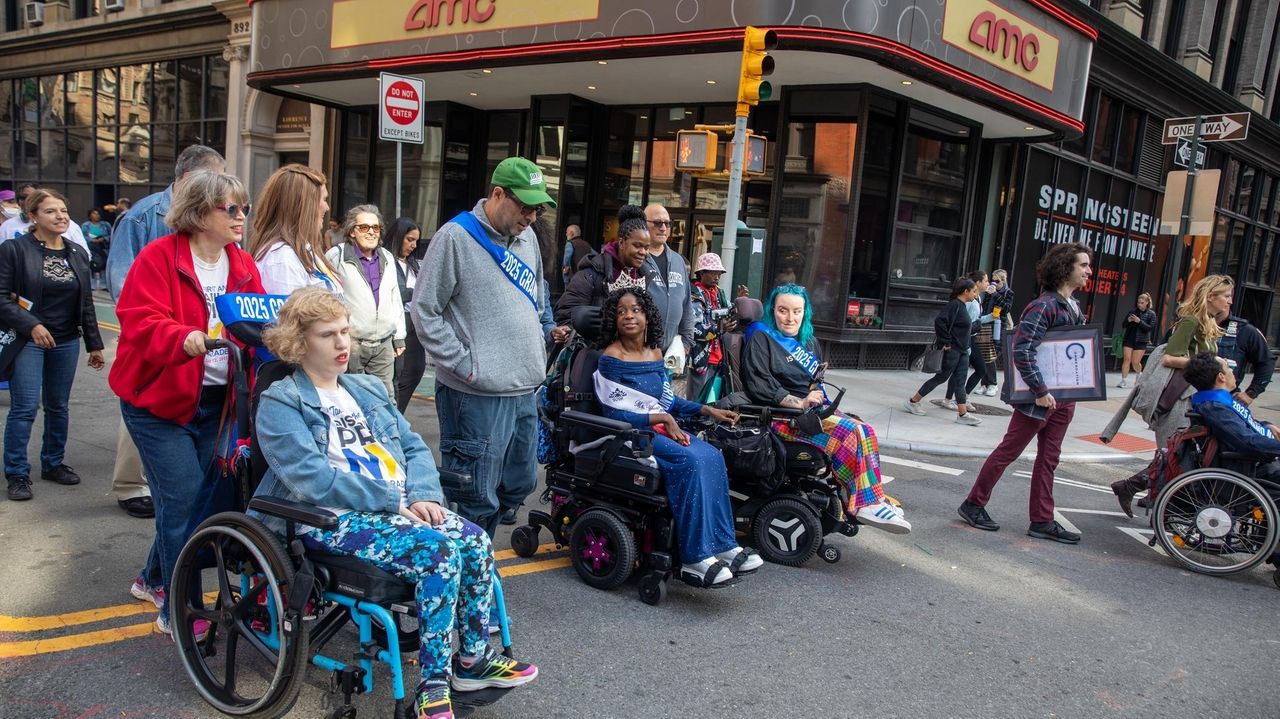Elisabeth Axel said growing up Port Washington, she was the quintessential “Long Island girl.”
Axel danced and played sports. Then, in middle school, she was diagnosed with encephalitis, a neurological disorder, and had to use a wheelchair.
One day, Axel told Newsday on Sunday, she was waiting outside a doctor’s office when a group of kids about her age started to stare. Axel eventually healed and no longer used a wheelchair but the moment stuck with her.
“They were looking at me, a person in a wheelchair, quite overweight,” Axel said. “I was such a different entity to them, than I had been as this other person, of the Port Washington dancing girl.”
On Sunday, Axel, 60, led a group of about 3,000 people down 5th Avenue in Manhattan from Madison Square Park to Union Square Park as part of the 10th annual Disability Pride Parade. The event is a “community-driven celebration,” said Axel, the president of the parade and the founder of the nonprofit Art Beyond Sight, who splits her time between Port Washington and Manhattan. “I’m learning all the time. Each year has been something different.”
“We are intersectional,” she added. “We are part of every community.”
Just behind Axel, who walked alongside a group of individuals using wheelchairs, was Brad Lander, the New York City Comptroller. The Comptroller’s office was a co-sponsor of the parade.
“The Disability Pride Parade is one of, in my opinion, the most important parades we have here in New York City,” Lander said. “It’s a civil rights issue, it’s a basic humanity issue, it’s an economic opportunity issue, it’s access for everyone — of course making subways accessible for people in wheelchairs also makes them accessible for parents, we’re all getting older, we’re only temporarily abled.”
That sentiment was echoed by representatives from Elevator Action Group, which advocates for making New York subway stations more accessible. Natalie Sciacca, who lives in Brooklyn and has family in Port Jefferson, has juvenile rheumatoid arthritis and uses a wheelchair.
“I didn’t really have good experiences when I used public transportation,” said Sciacca, 54, who was part of Elevator Action Group on Sunday. “Now I’m fortunate enough that I don’t have to. I have a car and my family helps transport me. But it still should be accessible for all. When my car is not working, it’s not easy to use public transportation.”
Adriana Miranda, a Hempstead resident and a senior at Hofstra University, is a field fellow for Headcount, a nonpartisan voter registration organization. After the parade, at Union Square Park, Miranda registered 22 new voters, several of whom had disabilities, she said.
Growing up, Miranda said, she spent time with people with disabilities while visiting her grandmother, who worked at a group home. She said its important for people from different marginalized groups to stand up for each other.
“Whatever is happening to other communities, it’s just a matter of time before it happens to yours,” said Miranda, 21. “If you’re not advocating for them, they don’t have to advocate for you. And I think we just need more compassion as people.”
About halfway through the parade, all eyes turned to a pair of girls who danced while using sign language gestures. As the crowd cheered, Axel joined the girls and busted out a few moves of her own, a big smile on her face. In that moment, Axel said, she felt like a Long Island girl again.
Joshua Needelman covers the Town of North Hempstead for Newsday. A Long Island native and University of Maryland graduate, his work has appeared in publications including The New York Times and The Washington Post.

